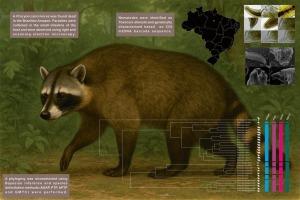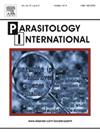First molecular characterization and species validation of Toxocara alienata (Rudolphi 1819) (Nematoda: Ascarididae), from a crab-eating raccoon (Procyon cancrivorus)
IF 1.9
4区 医学
Q3 PARASITOLOGY
引用次数: 0
Abstract
Toxocara alienata infects racoons and wild pigs in South America and its taxonomy is important to distinguish the species from closely related zoonotic congeners, such as T. canis. This study provides the first genetic characterization of T. alienata from the Brazilian Amazon, along with a comprehensive morphological description, to clarify its distinction from the closely related T. canis. Nematodes were observed using light and scanning electron microscopy and genetically characterized based on barcode COI mtDNA. A phylogeny was reconstructed using Bayesian inference and different species delimitation methods (PTP, bPTP, ASAP, GMYC) were performed for robust species validation. Specimens were identified as T. alienata based on a somewhat narrow cervical alae; male with equal, alate spicules, shorten than 1 mm, 28 pairs of caudal papillae (24 subventral precloacal pairs and 4 postcloacal pairs) and a protruded well-developed precloacal lip with an unpaired papilla on it, which was observed for the first time in the species. These morphological features can differentiate T. alienata from T. canis mainly regarding number and arrangement of postcloacal papillae, structure of precloacal lip and the presence of the unpaired papilla. In the phylogeny, T. alienata represented an independent lineage, sister to a clade formed by T. canis sequences. All species delimitation methods validated T. alienata as a specific entity, different from T. canis. The present results, including the first genetic characterization of T. alienata, reinforce its validation and provide crucial data for future taxonomic, epidemiological and ecological works on Toxocarinae.

来自食蟹浣熊(癌原浣熊)的异化弓形虫(Rudolphi 1819)(线虫目:蛔虫科)的首次分子鉴定和物种验证
异化弓形虫感染南美洲的浣熊和野猪,其分类对于区分该物种与密切相关的人畜共患病同系物(如犬弓形虫)具有重要意义。本研究首次对巴西亚马逊河流域的T. alienata进行了遗传鉴定,并对其进行了全面的形态学描述,以澄清其与密切相关的犬T. canis的区别。利用光镜和扫描电镜对线虫进行了观察,并利用COI mtDNA条形码对线虫进行了遗传鉴定。利用贝叶斯推理重建了一个系统发育,并采用不同的物种划分方法(PTP、bPTP、ASAP、GMYC)进行了稳健的物种验证。标本被鉴定为T. alienata基于一个有点狭窄的颈椎瓣;雄具等长的尖状针状体,短于1毫米,尾部乳头28对(腹下腔前对24对,后腔后对4对),突出发育良好的腔前唇,唇上有未配对的乳头,在本种中首次观察到。这些形态学特征主要体现在粪囊后乳头的数量和排列、粪囊前唇的结构以及有无未配对的乳头。在系统发育中,疏远犬代表了一个独立的分支,是由犬类序列形成的分支的姐妹。所有的种界划分方法都证实了异家鼠是一种不同于犬的特殊实体。本研究结果首次对弓形虫进行了遗传鉴定,为今后弓形虫的分类、流行病学和生态学研究提供了重要数据。
本文章由计算机程序翻译,如有差异,请以英文原文为准。
求助全文
约1分钟内获得全文
求助全文
来源期刊

Parasitology International
医学-寄生虫学
CiteScore
4.00
自引率
10.50%
发文量
140
审稿时长
61 days
期刊介绍:
Parasitology International provides a medium for rapid, carefully reviewed publications in the field of human and animal parasitology. Original papers, rapid communications, and original case reports from all geographical areas and covering all parasitological disciplines, including structure, immunology, cell biology, biochemistry, molecular biology, and systematics, may be submitted. Reviews on recent developments are invited regularly, but suggestions in this respect are welcome. Letters to the Editor commenting on any aspect of the Journal are also welcome.
 求助内容:
求助内容: 应助结果提醒方式:
应助结果提醒方式:


